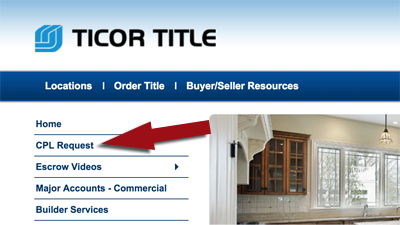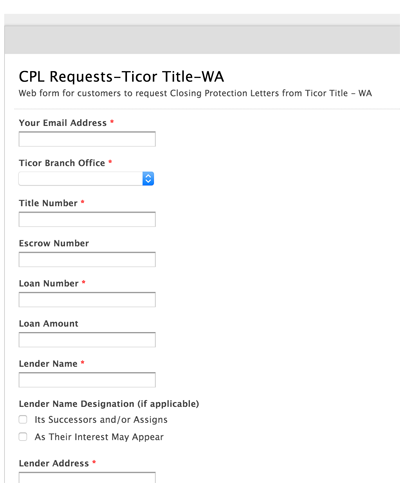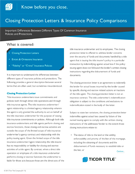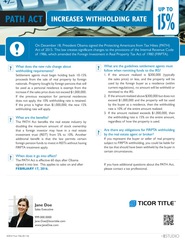 Ticor Title is proud to introduce a system by which we provide Closing Protection Letters (CPLs) in under one minute for our Lender Clients, providing convenience and a speedy response 24/7. When a Lender completes the CPL request form via MyTicor.com, a response via email with the completed CPL will be sent promptly.
Ticor Title is proud to introduce a system by which we provide Closing Protection Letters (CPLs) in under one minute for our Lender Clients, providing convenience and a speedy response 24/7. When a Lender completes the CPL request form via MyTicor.com, a response via email with the completed CPL will be sent promptly.
*Note that internet connection speeds, recipient email server functionality, and technological issues outside our control may have an impact on when a recipient receives CPL.
Here’s how to access a Closing Protection Letter in under one minute:
- Visit MyTicor.com and click on the “CPL Request” link in the left-hand navigation menu.

- Complete the CPL Request Form (including required fields marked with *)

- Check your email. The CPL will be delivered promptly to the email address specified in the Request Form.
Need to make edits to your CPL?
Sometimes things change as a transaction progresses. If you need to make an edit to any given CPL provided by our system, click the link at the bottom of the CPL titled: “CLICK HERE TO EDIT AND RE-CREATE THIS CPL”. The current information on your CPL will appear in the form where you may make edits as needed. Click the “Submit” button to submit your change request. Your revised CPL will be delivered via email as before.
Closing Protection Letters Explained
Title insurance underwriters issue commitments and policies both through direct title operations and through title insurance agents. The title insurance underwriter/ agent relationship is a limited agency relationship wherein the agent is only granted the authority to act on behalf of the title insurance underwriter for the purpose of issuing title insurance commitments or policies. Although both title insurance underwriters and title agents perform closing and escrow functions, those closing and escrow activities are outside the scope of the limited scope of title insurance underwriter’s agency contract and relationship with the policy issuing agent. Given the limited scope of the title insurance underwriter/agent relationship the title insurer has no responsibility or liability for closing and escrow activities of a title agent.
Closing Protection Letters &
Insurance Policy Comparisons
Important Differences Between Different Types Of CommonInsurance Policies and Protections

By contrast, when a direct title operation or employee of a title insurance underwriter performs closing or escrow functions the underwriter is liable for those acts because those are the direct acts of the title insurance underwriter and its employees. The closing protection letter is offered to address lender concerns over the security of funds and documents handled by a title agent that is issuing the title insurer’s policy in a particular transaction by indemnifying against actual loss if the policy issuing agent does not follow the lender’s written closing instructions regarding the disbursement of funds and documents.
The closing protection letter is an agreement to indemnify the lender for actual losses incurred by the lender caused by specific closing and escrow related actions or inactions of the title agent. The closing protection letter is not an insurance contract. The title underwriter’s indemnification obligation is subject to the conditions and exclusions to indemnification stated in the body of the letter.
Subject to state law variations, the closing protection letter indemnifies against actual loss caused by failure of the named issuing agent to comply with the written closing instructions of the addressee/lender to the extent those closing instructions relate to:
- The status of title to the land or the validity, enforceability and priority of the lien of the mortgage, including the obtaining of documents and the disbursement of funds necessary to establish title or the lien; or
- Fraud, dishonesty or negligence of the issuing agent in handling the addressee’s transactional funds or documents to the extent such fraud, dishonesty or negligence relates to the status of the title or the validity, enforceability and priority of the lien of the mortgage.
 On December 18, President Obama signed the Protecting Americans from Tax Hikes (PATH) Act of 2015. This law creates significant changes to the provisions of the Internal Revenue Code of 1986, which amended the Foreign Investment in Real Property Tax Act of 1980 (FIRPTA).
On December 18, President Obama signed the Protecting Americans from Tax Hikes (PATH) Act of 2015. This law creates significant changes to the provisions of the Internal Revenue Code of 1986, which amended the Foreign Investment in Real Property Tax Act of 1980 (FIRPTA).